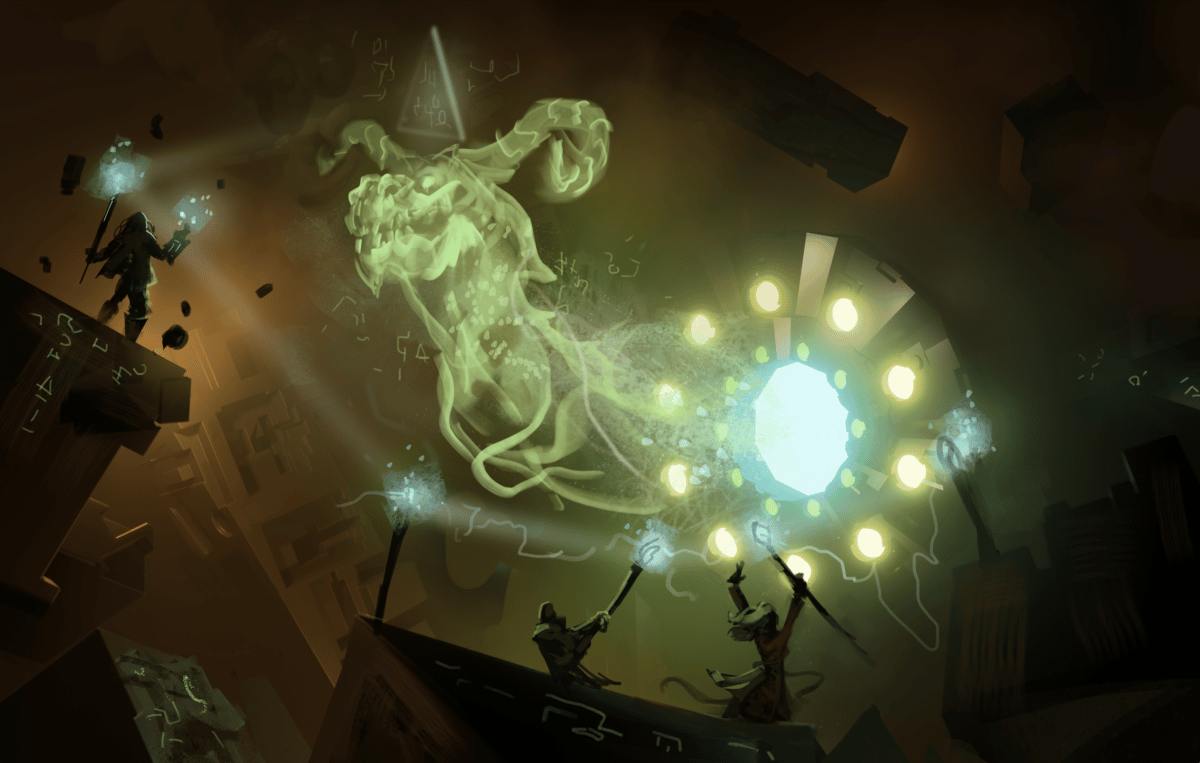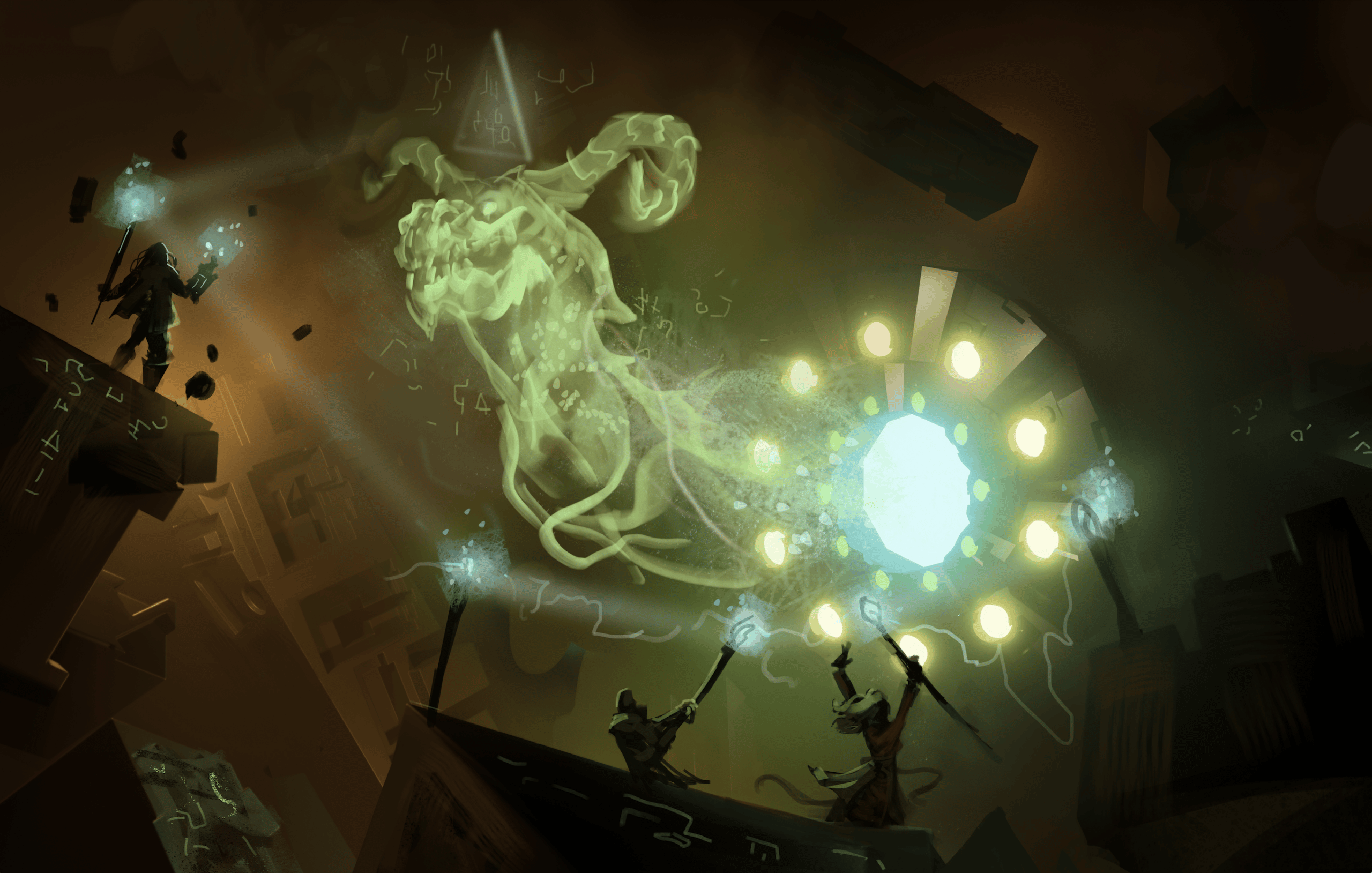If you are new to Dungeons and Dragons and perhaps have run a couple of purchased adventures, but would like to create your own – then this article is for you. If you are an old-school veteran who has been a Dungeon Master since the last millennia, read on anyway. This article is filled with useful pro-tips that you can add to your arsenal.
Let’s dive in and find out how to write an awesome D&D adventure!

Brainstorm ideas
Brainstorm ideas by flicking through the Monster Manual and build your adventure from there. If you know which type of monster you want to use, you can quickly figure out who the villain is and what type of theme or setting you want to use.
A simple adventure can be broken down into the following elements: a) A quest, b) Two monsters, c.) One trap, d) One boss fight, e) A treasure or reward.
This basic concept is great, and there are endless variation of the type of monsters, traps, or villains that you can choose from.
But let’s dig a little deeper, and get into storytelling and adventure act structure.
Adventure structure
The easiest way to begin is to divide the adventure into three parts. Part one of the adventure is the beginning, part two is the main adventure, and part three is the finale and ending. Lots of books, movies, and stories follow this type of structure, since it is a simple but highly effective way to build an adventure.
The beginning of an adventure
The beginning is the first part of the adventure when you set the tone and theme, present the quest, and let the characters gather equipment that they will need to successfully overcome the challenges. If the characters are low-level adventurers, you can consider allowing them to buy healing potions or scrolls that could be useful, or add these as loot early on during the quest.
This part of the adventure can also include a lot of interactions with NPCs, so that the characters can gather more information or hints about what they are up to. If the adventure has a twist, you can let the characters get the first clue about the final reveal.
Part one ends when the characters leave their safe area, for example the cosy inn, a small village, or the safe town, and head off towards an unsafe area, for example dangerous wilderness, a unexplored dungeon, or a mysterious castle.
Pro-tip: Break the rules! Sometimes it is fun to start an adventure in full-throttle mode! Let the door to the inn be bashed down by a crazy-looking goblin with red eyes. Once the characters have dealt with the goblin, the mayor’s son has been kidnapped and the characters have to leave the inn in the middle of the night!
The journey begins
Part two of the adventure begins when the characters have left their base and are travelling from point A to point B. To make the journey more interesting, add an encounter on the way. This doesn’t have to be directly linked to the main adventure, but could be a small mini-adventure in itself.
An encounter can be a friendly encounter, e.g. a travelling wanderer or someone fleeing from the nasty goblins that the characters have decided to deal with. The encounter can result in that an NPC shares information or a small reward. The encounter can also be a fighting encounter, where the characters have to draw their swords or staves.
It is good if the encounter somehow is connected to the main adventure and enhances its theme or setting. Instead of adding random fire elementals or highway robbers, use ghosts, ghouls, or werewolves for a vampire adventure, et cetera.
The encounter can also be of a more atmospheric nature. Atmospheric encounters can be used to augment the theme and setting (as mentioned above). For example, it can be a small overgrown grave by a crossroad where someone has left dead flowers, or that one of the characters dreams nightmares that are tied to the main adventure.
Pro-tip: This encounter doesn’t have to feature combat, but if the characters have spent lots of time interacting with NPCs and gathering equipment at the beginning of the adventure, it is good to break the slower pace with some action.
Arriving to the destination
Once the characters have finished their journey, they arrive to the location where the main event will take place. This is traditionally some sort of dungeon, or dungeon-like location, but there are plenty of options that you can choose from to make it more interesting for your players: a sunken temple to navigate, a feywild castle filled with odd rooms to investigate, a strange maze in the deepest part of the forest, or a mysterious haunted mansion where the rooms shift.
The characters must now explore the area to deal with the main villain. I usually use three encounters for this part of the adventure to let all the characters have a possibility to shine: one fighting encounter, one magical trap or puzzle, and one locked door/locked item/hidden passage.
You can add loot for a few of these encounters. For example: monsters can carry coin, weapons, or useful items, while secret areas or looked chests can reveal hidden treasures. The type of treasures can either be decided by using the random tables in Dungeon Master’s Guide, but it is usually more fun if they are directly linked to the theme of the adventure . If you like, add various types of items that might not have any value, but still indirectly add to the storytelling and narrative of the adventure. Letters and diaries are great way to share background information, but smaller items can enhance the theme, too. For example, in a pirate adventure you can add items such as strange Aztec-looking coins (that are fake), the ship’s journal, a bottle with a tiny ship inside, a hidden pirate flag, half a bottle of black rum, a small carved statue of a mermaid.
Pro-tip: If you are running an adventure for low-level characters, let them have the possibility to take long rests to replenish hit points and regain spells. However, if the characters are high-level, add something that prevents them from doing so (maybe they have to kill the main boss before midnight, or they take direct damage from being in the dungeon.)
Finale!
The final encounter is a boss fight with the adventure’s main villain. This usually takes place at the boss’ lair (our party killed Count Strahd in his own kitchen. Vampire, schvampire!).
One way of making the final fight truly epic is to make the surrounding environment more dangerous. For example: a swordfight on an unstable hanging bridge while the villain’s minions are trying to saw through the rope to the bridge is much more interesting and dangerous than a normal swordfight!
Another example is to let something specific happen when the main villain has lost half of their hit points. Perhaps they will summon monsters to fight for them or drink a potion of invisibility in an attempt to turn the fight to their favour or to make a stealthy escape, or perhaps they will pull a lever in the wall that will set off a lethal trap that deals damage to all the characters each round.
Pro-tips: Several monsters are harder – and more unpredictable – than one single encounter. For this reason, it is best to use one single encounters for low-level characters. However, if the characters are high-level, don’t be afraid to add minions, summoned creatures, or loyal henchmen who fight to their death!
The end
If the characters defeat the main boss, reward them with finding a great treasure. The characters could receive a reward for solving their mission from the quest-giver, but a bonus treasure that consists of gold and magical items are always appreciated. As mentioned previously, you can either use random tables to select magical items, or hand-pick them to suit the adventure’s tone and setting.
Pro-tip: Most adventures end with the characters digging through a large treasure chest, but personally I like it when the characters have the opportunity to return to their starting point where the adventure began. This leads the adventure to a full circle and gives the story a nice ending. It doesn’t have to take up a lot of time – in fact, you can fast-forward the return journey and simply describe it as an epilogue. This gives the characters the opportunity to return to the quest giver and get their reward, but they also have the possibility to accept the thanks from the rest of the community. These could be a free meal and drinks all around, a medal, a speech, celebrations, or the promise of a future favour. It also give the characters the possibility to interact further with NPCs, which later can lead to new adventures.

